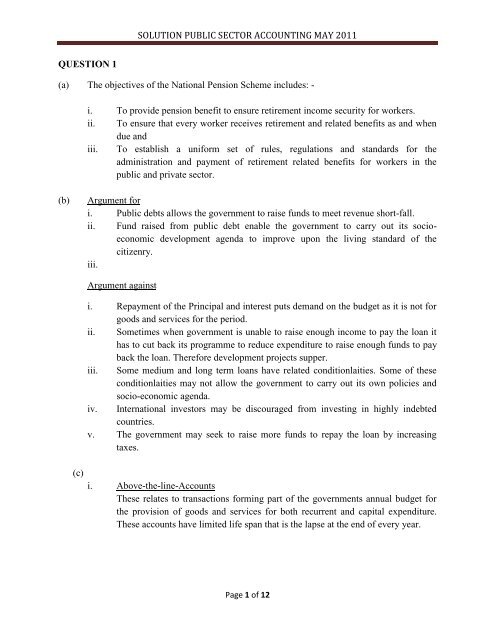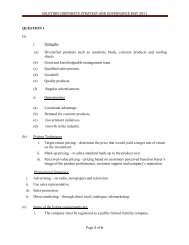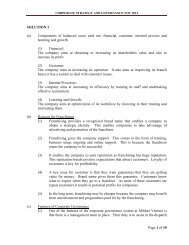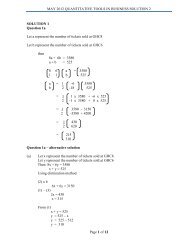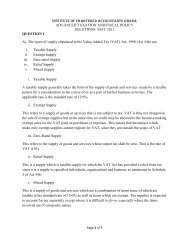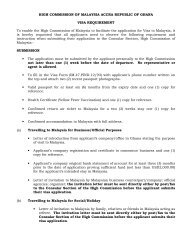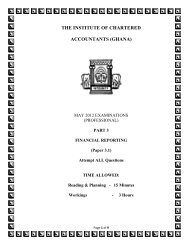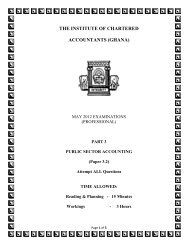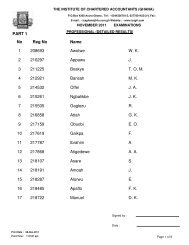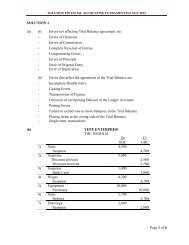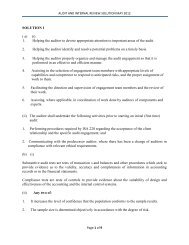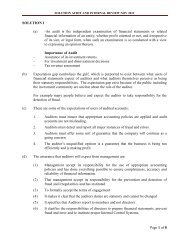solution public sector accounting may 2011 - The Institute of ...
solution public sector accounting may 2011 - The Institute of ...
solution public sector accounting may 2011 - The Institute of ...
You also want an ePaper? Increase the reach of your titles
YUMPU automatically turns print PDFs into web optimized ePapers that Google loves.
SOLUTION PUBLIC SECTOR ACCOUNTING MAY <strong>2011</strong>QUESTION 1(a) <strong>The</strong> objectives <strong>of</strong> the National Pension Scheme includes: -i. To provide pension benefit to ensure retirement income security for workers.ii. To ensure that every worker receives retirement and related benefits as and whendue andiii. To establish a uniform set <strong>of</strong> rules, regulations and standards for theadministration and payment <strong>of</strong> retirement related benefits for workers in the<strong>public</strong> and private <strong>sector</strong>.(b)Argument fori. Public debts allows the government to raise funds to meet revenue short-fall.ii. Fund raised from <strong>public</strong> debt enable the government to carry out its socioeconomicdevelopment agenda to improve upon the living standard <strong>of</strong> thecitizenry.iii.Argument againsti. Repayment <strong>of</strong> the Principal and interest puts demand on the budget as it is not forgoods and services for the period.ii. Sometimes when government is unable to raise enough income to pay the loan ithas to cut back its programme to reduce expenditure to raise enough funds to payback the loan. <strong>The</strong>refore development projects supper.iii. Some medium and long term loans have related conditionlaities. Some <strong>of</strong> theseconditionlaities <strong>may</strong> not allow the government to carry out its own policies andsocio-economic agenda.iv. International investors <strong>may</strong> be discouraged from investing in highly indebtedcountries.v. <strong>The</strong> government <strong>may</strong> seek to raise more funds to repay the loan by increasingtaxes.(c)i. Above-the-line-Accounts<strong>The</strong>se relates to transactions forming part <strong>of</strong> the governments annual budget forthe provision <strong>of</strong> goods and services for both recurrent and capital expenditure.<strong>The</strong>se accounts have limited life span that is the lapse at the end <strong>of</strong> every year.Page 1 <strong>of</strong> 12
SOLUTION PUBLIC SECTOR ACCOUNTING MAY <strong>2011</strong>ii.iii.iv.General Revenue Balance<strong>The</strong> net balance <strong>of</strong> all the above-the-line-accounts is known as General RevenueBalance. It is made up <strong>of</strong> unspent revenue where expenditure has not yet beencommitted.At the end <strong>of</strong> each financial year this balance is transferred below the line toreserves.District Assembly Common Fund<strong>The</strong> Common fund Act, (Act 455) <strong>of</strong> 1993 defines the District AssemblyCommon Fund as a fund consisting <strong>of</strong> all moneys allocated by Parliament andinterest and dividend accruing from investment and dividend accruing frominvestment <strong>of</strong> money from the common fund.FundA fund <strong>may</strong> be defined as independent <strong>accounting</strong> entity and must be accountedfor using separate identifiable sets <strong>of</strong> accounts in such a way that it is possible toidentify specific assets and liabilities that represent the balance on accounts.A fund is a sub-division <strong>of</strong> fiscal activities, assets, liabilities, revenue andexpenditures <strong>of</strong> the organization, related to the conduct <strong>of</strong> a specific function,activity or attainment <strong>of</strong> specific objective. Thus a fund is a separate <strong>accounting</strong>entity, operating within a framework <strong>of</strong> specific controls with self balancing set <strong>of</strong>accounts.A fund <strong>may</strong> have: -a. Transactions within itself.b. Transactions with external parties.c. Transactions with other funds <strong>of</strong> the same organization.d. Each fund applies full double entry to record the transactions.(d)<strong>The</strong> selection <strong>of</strong> projects for support by Member <strong>of</strong> Parliament under the constituencyfund should conform to National and District Development plans and objectives.Guidelines for the selection <strong>of</strong> projects by Member <strong>of</strong> Parliament are that the projectsshould:i. Fall within the scope <strong>of</strong> functions <strong>of</strong> the District Assembly.ii. Correspond to the poverty reduction strategy <strong>of</strong> the District Assembly.iii. Provide infrastructure in the area <strong>of</strong> education, health, road, streets and dams.iv. Generate sustainable employment.v. Aim at income generation and wealth creation.Page 2 <strong>of</strong> 12
SOLUTION PUBLIC SECTOR ACCOUNTING MAY <strong>2011</strong>Rubber ProductsMetal ProductsPlastic WareGlasswareAluminum WarePETROLEUM TAXES ONPremiumiv.LICENSESAuctioneersGame LicenseDogs (Pet)Fire-ArmsGoldsmithsHuntersLetter WritersMining, Dredging, Prospecting etc.Motor lendersMotor and DrivingPawn BrokersPetrolPharmacy and PoisonSchool fees(e)<strong>The</strong> procedure for the disposal <strong>of</strong> obsolete and surplus items in a government departmentinclude:i. Transfer to government departments or other <strong>public</strong> entities, with or withoutfinancial adjustment.ii. Sale by <strong>public</strong> tender to the highest tendered, subject to reserve price.iii. Sale by actions, subject to a reserve price.iv. Distruction, dumping or burying as appropriate.QUESTION 3(a)Overall process <strong>of</strong> reviewing and controlling financial resources.Page 5 <strong>of</strong> 12
SOLUTION PUBLIC SECTOR ACCOUNTING MAY <strong>2011</strong>(b)(c)(e.)Benefits <strong>of</strong> financial controls: It gives clear definition <strong>of</strong> responsibilities It reflects current position <strong>of</strong> organisation. It presents information that can be easily assimilated and understood. It allows comparability <strong>of</strong> budgets with income and expenditure.Financial Income Expenditure Commitments BudgetsPublic Sector Accounting Systems:Vote AccountingIt is concerned with the receipt, custody, disbursement, and transfer <strong>of</strong> <strong>public</strong> and trustmonies as required by law.Fund AccountingA fund is an independent <strong>accounting</strong> entity and must be accounted for using a separatelyidentified set <strong>of</strong> accounts in such a way that it is possible to identify the specific assetsand liabilities that represent the balance on the fund.Project AccountingIt involves controlling, measuring and analyzing the activities and lifeline <strong>of</strong> a specificproject.Donor Support AccountingThis is concerned with receipts, custody and disbursement <strong>of</strong> the financial donation <strong>of</strong>donor or support organizations.(f.)Benefits <strong>of</strong> the <strong>accounting</strong> systems outlined in (e.) Formulate the general objectives <strong>of</strong> the agency and co-ordinate the policies <strong>of</strong>individuals financial needs <strong>of</strong> the various units. Relate each spending units requirements to the economic resources estimated tobe available and the total claims to them; Keep expenditure within total resources <strong>of</strong> the year. Advise management and each unit about financial control measures <strong>of</strong> the agency.Page 6 <strong>of</strong> 12
SOLUTION PUBLIC SECTOR ACCOUNTING MAY <strong>2011</strong>QUESTION 4(a)<strong>The</strong> four factors are:1. Objectives <strong>of</strong> the state (vision <strong>of</strong> government)2. Fiscal policy (taxation etc.)3. Monetary policy (inflation, money supply etc.)4. <strong>The</strong> estimates(costing <strong>of</strong> activities)Explanation <strong>of</strong> the four factors.1. <strong>The</strong> objectives <strong>of</strong> the state, varies from period to period and depends on whichgovernment is in power. <strong>The</strong> broad national objectives are captured in the DirectivePrinciples <strong>of</strong> state policy in the nation’s constitution a decade ago; the objective wasvision 2020, a brand policy to move Ghana to the middle income status. This objectivewas to move the timeframe to 2015 with the launch <strong>of</strong> Growth and Poverty ReductionStrategy. At present there is a new policy direction with four thematic areas: Investment n human capital. Expansion <strong>of</strong> infrastructure. Job creation. Transparent and accountable governance.2. Government fiscal policy is the term used for the government’s policy <strong>of</strong> taxation,payments and financing deficit gaps. <strong>The</strong> government raises through taxation to carry outits programme. It is the amount through taxation is insufficient, for the budgetedprogrammes then other means <strong>of</strong> raising funds are used to meet the deficit. This isnormally achieved by borrowing on the local market by means <strong>of</strong> treasury bills orborrowing externally from multi-donor institutions like IMF and World Bank or look forgrants or donations.3. <strong>The</strong> supply <strong>of</strong> money in the economy determines economic activity and the prevailingprice level. Attention is therefore focused on bank <strong>of</strong> Ghana and it’s attempt to regulatethe money supply <strong>of</strong> the country. Economists believe that if the supply increases beyondthe normal increase in economic activity (about 4 -5 %p.a.) inflationary spending ensues.Similarly, if the growth in the money supply is below the level <strong>of</strong> economic activityrecessionary tendencies increases.4. <strong>The</strong> annual estimates are prepared in quantitative terms using the government chart <strong>of</strong>accounts and MTEF principles <strong>of</strong> planning and programming.From the annual estimates government is able to know. Projected revenue and expenditure for the year. <strong>The</strong> allocation <strong>of</strong> funds for various functions and programmes includingadministration, service and investments. Whether it will have surplus or deficit in its current accounts and to plan whetherto borrow or invest funds.Page 7 <strong>of</strong> 12
SOLUTION PUBLIC SECTOR ACCOUNTING MAY <strong>2011</strong>And to decide on the appropriate level and structure <strong>of</strong> <strong>public</strong> debts.(b) i. Notification <strong>of</strong> approved estimateAfter Parliamentary approval, approval estimate shall be communicated to theController and Accountant by the issue <strong>of</strong> a General Warrant with copies to theAuditor-General and MDA’s. <strong>The</strong> Controller and Accountant Generalcommunicate the approval to the MDA’s by the issue <strong>of</strong> Departmental Warrantsto respective MDA’s based on the MOFEP general warrant.ii.Evasion <strong>of</strong> Expenditure ControlA head <strong>of</strong> Department shall not vary the normal course <strong>of</strong> payment to avoidcausing an excess on any items <strong>of</strong> expenditure or to avoid lapse <strong>of</strong> funds and inparticular shall not:Make payments in advance for goods or services to be delivered in thesubsequent year.Place funds in deposits with service providers or any other category toavoid the consequences <strong>of</strong> lapse <strong>of</strong> funds.iii.Progressive taxTax policy is said to be progressive when the high income earners are made topay more than the low income earners. As such progressive tax is said to fair andequitable.(c.)Functions <strong>of</strong> the Trust include:i. To operate the basic National Social security Pension Scheme and other schemes as <strong>may</strong>be prescribe by law.ii.iii.iv.To create a fund into which shall be paid the contribution and any other money’s as <strong>may</strong>be required under the Act.To be responsible for the general administrative <strong>of</strong> the social security scheme andregulations made under it.To ensure the provision <strong>of</strong> social protection for the working population for variouscontingencies including old age, invalidity and death.v. To be responsible for the administration and investment <strong>of</strong> funds within the framework <strong>of</strong>general directives issued by the Board <strong>of</strong> Trustees and approved by the authority.vi.Perform any other functions that are ancillary to the object <strong>of</strong> the truth.Page 8 <strong>of</strong> 12
SOLUTION PUBLIC SECTOR ACCOUNTING MAY <strong>2011</strong>QUESTION 5Ledger EntriesGOG Fund AccountGHSGHSBal c/d 3,500,000 Cash 3,500,000Bal b/d 3,500,000Internally Generated Fund (IGF)GHSGHSI & EXP 1,200,000 Cash 950,000Outstanding IGF 250,0001,200,000 1,200,000Bal b/d 1,200,000Donation (NGO) AccountGHSGHSBal. b/d 3,500,000 Cash 3,300,000Bal b/d 3,300,000Outstanding (IGF)GHSGHSI.G.F 250,000 Bal. c/d 250,000250,000 250,000Bal. b/d 250,000Cash BookGHSBal. b/d 2,000,000Personal emolument2,450,000GOG Funds 3,500,000 Administration2,500,000I.G.F. 950,000 Service Activities1,500,000N.G.O.(Donation) 3,300,000 Investment1,000,000Bal. c/d2,300,0009,750,0009,750,000Bal. b/d 700,000GHSPage 9 <strong>of</strong> 12
SOLUTION PUBLIC SECTOR ACCOUNTING MAY <strong>2011</strong>Personal EmolumentGHSGHSCash 2,450,000 Bal.b/d 800,000Bal. c/d 1,650,0002,450,000 2,450,000Bal .b/d 1,650,000AdministrationGHSGHSCash 2,500,000 Bal.b/d 2,500,0002,500,000 2,500,000Bal.b/d 2,500,000Service ActivitiesGHSGHSCash 1,500,000 Bal.b/d 1,500,0000Bal .b/d 1,500,000InvestmentGHSGHSCash 1.000,000 Bal.c/d 1,000,000Bal. b/d 1,000,000Reserved FundsGHSGHSBal.c/d 600,000 Bal. b/d 400,000Unreserved Fund 200,000600,000 600,000Bal. b/d 600,000Unreserved FundsGHSGHSReserved fund 200,000 Bal.b/d 1,200,000Bal.c/d 2,350,000 Income & exp. 1,350,0002,550,000 2,550,000Bal. b/d 2,350,000Page 10 <strong>of</strong> 12
SOLUTION PUBLIC SECTOR ACCOUNTING MAY <strong>2011</strong>InventoryGHSGHSBal. b/d 400,000 Bal. c/d 400,000Bal. b/d 400,000(b)Department <strong>of</strong> ForestryTrial Balance for the year ended 30 th June, 2009DRCRGHS GHSGOG Fund 3,500,000I.G.F. 950,000Donation (NGO) 3,300,000Cash 2,300,000P.E. 1,650,000Administration 2,500,000Service activities 1,500,000Investment 1,000,000Reserved Fund 600,000Unreserved 1,000,000Inventory __400,000 ________9,350,000 9,350,000(c ) Department <strong>of</strong> ForestryIncome and Expenditure for the Year Ended 30 th June, 2009Budget Actual VarianceIncome GHS GHS GHSGOG Funds 4,000,000 3,500,000 (500,000)I.G.F. 2,000,000 1,200,000 (800,0000Donations (NGO) 2,500,000 3,300,000 800,0008,500,000 8,000,000 (500,000)ExpenditureP.E. 1,800,000 1,650,000 150,000Administration 2,700,000 2,500,000 200,000Service Activities 2,200,000 1,500,000 700,000Investments 1,200,000 1,000,000 200,0007,900,000 6,650,000 1,250,000Page 11 <strong>of</strong> 12
SOLUTION PUBLIC SECTOR ACCOUNTING MAY <strong>2011</strong>Excess income over expenditure 600,000 1,350,000 750,000Add reserves b/f_1,600,002,950,000(a.) Department <strong>of</strong> ForestryBalance sheet as at 30 th June, 2009GHSAssetsCash 2,300,000Inventory 400,000Outstanding IGF (receivable) 250,0002,950,000Liabilities and FundsFunds reserved 600,000Unreserved funds 2,350,0002,950,000Page 12 <strong>of</strong> 12


